Possibly a foolish decision… we asked the contractors to leave us the nicest bricks from our old, crumbling, 1896 brick foundation. Now we have this large pile of bricks in our backyard ready to collect spiders and who knows what else.
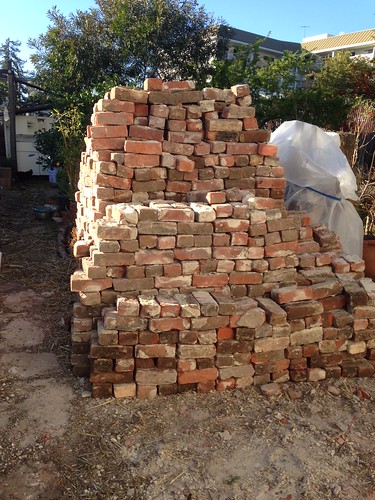
Possibly a foolish decision… we asked the contractors to leave us the nicest bricks from our old, crumbling, 1896 brick foundation. Now we have this large pile of bricks in our backyard ready to collect spiders and who knows what else.

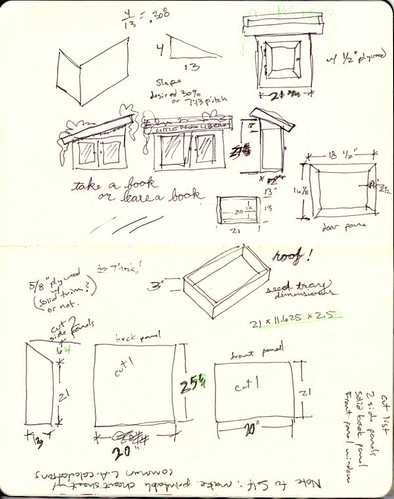
Little Free Libraries are small personally managed 'take a book or leave a book' libraries. They are usually adorable. You can look at their Flickr gallery to see some examples of the awesomeness that people create.If you want to have your library registered and affiliated with the site you need to pay a small fee. They send you an official plaque and list your library on their map so people can find you.I would like to make mine with a green roof! I am not a builder type though and have no tools. I have a couple of friends who are and I plan on commissioning them to make this for me.
Here is my final concept:

I'm close to being done with this dress. I have been prototyping the brooches. First in tissue paper and then with wool felt and embroidery.
I bought myself the book Land Art in Town: Simple Inspiration Through the Seasons for Christmas this year. It is an awesome book. The author, Marc Pouyet, hung out in cities across Europe and made and photographed his land art. I call it nature art and think of land art as bigger earthworks type stuff. I'm more drawn to this smaller scale, urban, unexpected art using nature.Here are some of the things my sister, son and I created.
This is a project from a design class a few semesters ago. It is a sloped site in El Cerrito with nice views and a daylighted culvert.It had an interesting feature in the backyard - a serpentine brick wall, also called a crinkle crankle wall. Neat! It seemed oddly wasted as a wall along a narrow path at the back of the house where no one would ever see it if it was meant to be decorative. However, it DID make sense once I learned that a brick serpentine wall is a very strong retaining wall. It can be only one brick thick, saving space and money while adding some visual interest.
"This ingenious technique of garden wall construction has been used for several hundred years. The serpentine shape provides lateral strength to the wall so that it normally can be built only 4 in. in thickness without additional lateral support. Since the serpentine wall depends on its shape for lateral strength, it is important that the degree of curvature be sufficient. The following general rule is based upon the performance of many successful serpentine walls. The radius of curvature of a 4 - in. wall should be no more than twice the height of the wall above finished grade, and the depth of curvature should be no less than 1/2 of the height." -from http://www.gobrick.com/
The daylighted culvert was another interesting feature. The easements surrounding it meant we couldn't do anything to change it to make it less all about ugly concrete. Still, it provided a nice water sound and wildlife habitat.The assignment was to create a landscape plan and plant list for the front and backyard and do all the Water Efficient Landscape Ordinance calculations.
"There are two water budgets in the Model Ordinance; the Maximum Applied Water Allowance (MAWA) and the Estimated Total Water Use (ETWU).The MAWA, is the water budget used for compliance and is an annual water allowance based on landscape area, local evapotranspiration and ETAF of 0.7. The ETWU is an annual water use estimation for design purposes and is based on the water needs of the plants actually chosen for a given landscape. The ETWU may not exceed the MAWA." - from The Updated Model Water Efficient Landscape Ordinance Brochure
This was also the property used in my concurrent Grading and Drainage class. We used a zip level to map the site elevations and worked out a complete grading and drainage plan for the property.
Another brick serpentine wall resource: http://www.masonryconstruction.com/
This is a great project off to a great start. Stage One has been completed with much community help and the kids have been having a blast exploring it.This is an under used area at a progressive private school (grades K-8). K and 1st grade teachers have requested this area be transformed in to Create with Nature and natural playscape area.After meetings with the teachers and Landscape Committee I came up with a fun plan that can be completed in various stages as budget become available Teacher Requests- Largish circle of stumps (in combo w/ plants) to enclose the Create With Nature Zone- Create ‘Storage Library’ for loose parts and tools - organized baskets of materials- Ability to take over that whole space - involves moving nursery area- Moving the mulch pile over- Barriers to keep kids out of parking area and out from under delicate oaks- Incorporation of other play elements -- Water, Playhouse, Interesting plants, PathwaysZones- Create with Nature Zone - Enclosed by plants and stumps, inside are some movable stumps and some larger immovable stumps to build on- Loose Parts Library - Includes wicker baskets, wine crates or other containers with well organized loose parts- Mulch Mountain - Large persistent pile of mulch to be replaced as it breaks down or is used elsewhere- River Bed - Includes child friendly hand pump to access water, water flows into basins or sluice and down into dry river bed w/ bridge for crossing- Pathways - Mulch pathways, include two clear entrances, pavers under oaks through plantings, pavers for a curvy path leading to living willow tunnel- Barriers - Natural fencing (willow or branches) along parking area, low mosaic seating wall at south edge, under oak plantings- Playhouse - Small 3 sided playhouse made from natural materials - willow or branchesStage 1 - Oct 6th - Main goal is to build Create with Nature Zone and Library of loose parts.Stump circle - Arrange and dig stumps as we have into largish area surrounding treeLibrary - Low, kid accessible shelves for storing baskets of loose partsLoose parts - Tree cookies, tree blocks, smooth river stones, twigs, pinecones, bamboo pieces, interesting seed pods, any interesting plant materialTools - Small brooms, rakes, trowels[metaslider id=746]Next Stages:Stage 2: move mulch pile, create fencing along parking area, build willow/branch playhouseStage 3: plantings and pathwaysStage 4: incorporate water, boulders, watercourse and bridgeStage 5: K and 1st students create mosaic tiles, organize community mosaic buildAlso viewable on my Projects page!
Teacher Requests- Largish circle of stumps (in combo w/ plants) to enclose the Create With Nature Zone- Create ‘Storage Library’ for loose parts and tools - organized baskets of materials- Ability to take over that whole space - involves moving nursery area- Moving the mulch pile over- Barriers to keep kids out of parking area and out from under delicate oaks- Incorporation of other play elements -- Water, Playhouse, Interesting plants, PathwaysZones- Create with Nature Zone - Enclosed by plants and stumps, inside are some movable stumps and some larger immovable stumps to build on- Loose Parts Library - Includes wicker baskets, wine crates or other containers with well organized loose parts- Mulch Mountain - Large persistent pile of mulch to be replaced as it breaks down or is used elsewhere- River Bed - Includes child friendly hand pump to access water, water flows into basins or sluice and down into dry river bed w/ bridge for crossing- Pathways - Mulch pathways, include two clear entrances, pavers under oaks through plantings, pavers for a curvy path leading to living willow tunnel- Barriers - Natural fencing (willow or branches) along parking area, low mosaic seating wall at south edge, under oak plantings- Playhouse - Small 3 sided playhouse made from natural materials - willow or branchesStage 1 - Oct 6th - Main goal is to build Create with Nature Zone and Library of loose parts.Stump circle - Arrange and dig stumps as we have into largish area surrounding treeLibrary - Low, kid accessible shelves for storing baskets of loose partsLoose parts - Tree cookies, tree blocks, smooth river stones, twigs, pinecones, bamboo pieces, interesting seed pods, any interesting plant materialTools - Small brooms, rakes, trowels[metaslider id=746]Next Stages:Stage 2: move mulch pile, create fencing along parking area, build willow/branch playhouseStage 3: plantings and pathwaysStage 4: incorporate water, boulders, watercourse and bridgeStage 5: K and 1st students create mosaic tiles, organize community mosaic buildAlso viewable on my Projects page!
One of the things I enjoy most from our garden in the spring is the chamomile. Fresh chamomile tea is NOTHING like the stuff you might get in a tea bag. This year I have made infused oils using chamomile flowers, comfrey, calendula, and lavender from my garden.My first experiment was to make a whipped coconut oil body butter using the recipe on The Nourished Life. I added in comfrey and chamomile. Whipping the coconut oil gives it a soft texture and you can scoop it out of a jar easily. It's quite nice but I wanted more.I tried my hand at making a salve. I sort of roughly followed this recipe from Ramblings of a Happy Homemaker. I used coconut oil, beeswax, and, calendula, lavender, comfrey, and chamomile oils, and also some vitamin E oil.For my next trick I will try with some grapeseed oil. In fact, I might start infusing grape seed oil instead of olive oil and incorporating some local honey would kind of rock too. Crunchy Betty has a nice sounding recipe that includes honey.I made the mistake of smearing some salve all over myself, forgetting that salve does NOT equal lotion. So yeah. The whipped coconut oil worked well as a lotion. it wqasnt too heavy or greasy and absorbed into my skin nicely. I might try a recipe similar to this one at To Come Full Circle with clove. The following list is taken from http://www.natural-homeremedies-for-life.com.Coconut oil ~ Super moisturizing oil, a solid at room temperature but melts easily on the skin. Its consistency makes it very easy to mix and very useful in facial masks. Protects skin from the elements by forming a thin film which is not absorbed. Also useful as an after sun oil. Good cleansing properties and very mild.Comfrey – Contains allantoin, an ingredient that promotes healing, and is known for its regenerating and soothing properties. The extract of the Comfrey plant is anti-inflammatory, astringent and emollient. It can help the healing of open wounds, cuts, burns, and bruisesLavender ~ Soothes and calmes your skin, has antiviral, anti-fungal, antiseptic and anti-inflammatory properties. Can relieve muscle tension, speeds healing and reduces scarring. Also works as anti depressant, stimulates circulation, is a mild sedative and reduces nervous tension.Chamomile ~ There are Roman and German chamomile. They are rejuvenating and relaxing and have soothing effect on burns and irritations. Are also slightly sedative.Beeswax ~ Beeswax locks in moisture, fosters cells and protects skin from damaging environmental factors. Honeygirlorganic.com reports beeswax effectively "softens your skin and creates a long-lasting protective coating against the elements. It also is a naturally nourishing moisturizer as well as being anti-inflammatory, antibacterial, anti-allergenic and a germicidal antioxidant." According to Botanical.com, "Even after processing, beeswax still remains a biologically active product, retaining some anti-bacterial properties and also contains some vitamin A, which is necessary for normal cell development." The Mayo Clinic recommends lip balm made from beeswax for chapped lip care and prevention.Since beeswax does not clog pores, Dermaxime.com states, "When it is properly used, (beeswax) will not promote the formation of acne or pimples."
My first Garden Bloggers' Bloom Day post a few days late. :PWhat is happening back here flower wise these days?Zucchini Flower!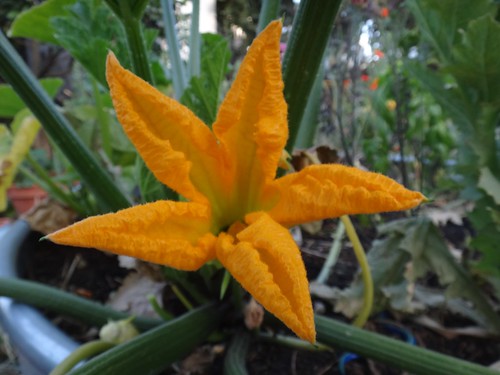 Poppies, poppies and more poppies.
Poppies, poppies and more poppies.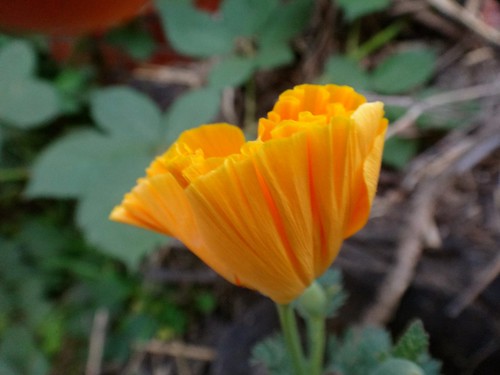 Yarrow and CA fushias and salvia clevelandii.
Yarrow and CA fushias and salvia clevelandii.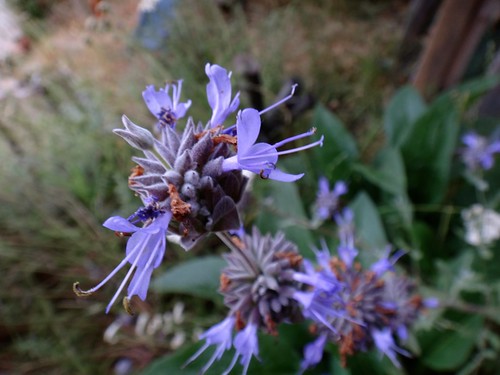 Roses.
Roses.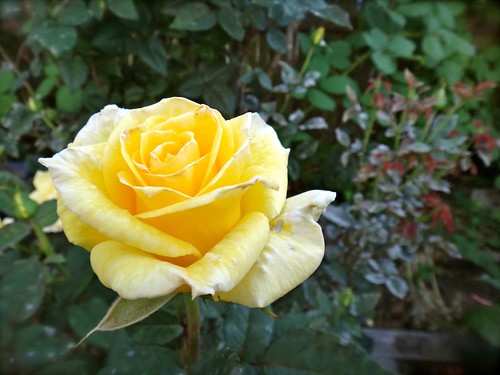 Cerinthe major
Cerinthe major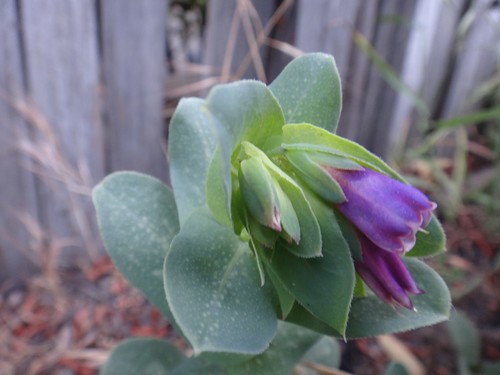 Mimulus.
Mimulus.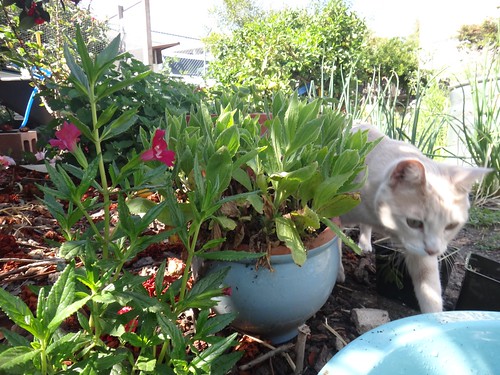 I bought a few small plants yesterday so maybe I'll have an actual in bloom flower bed later this year. :)
I bought a few small plants yesterday so maybe I'll have an actual in bloom flower bed later this year. :)
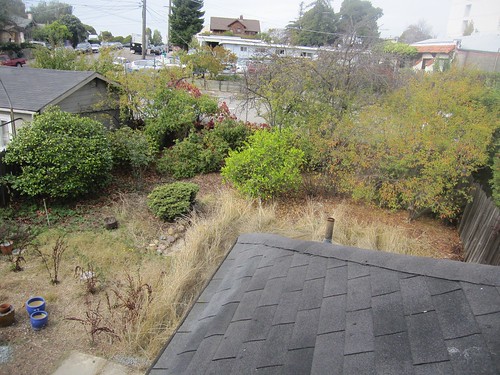
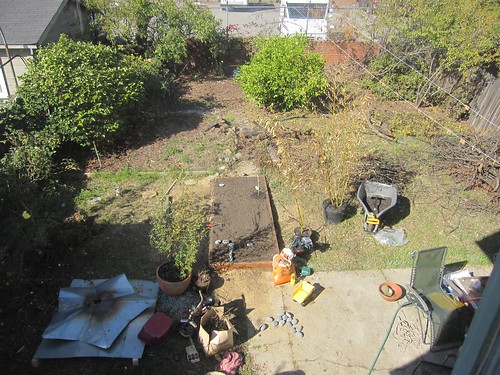

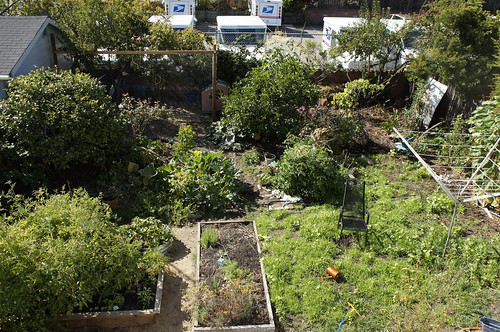
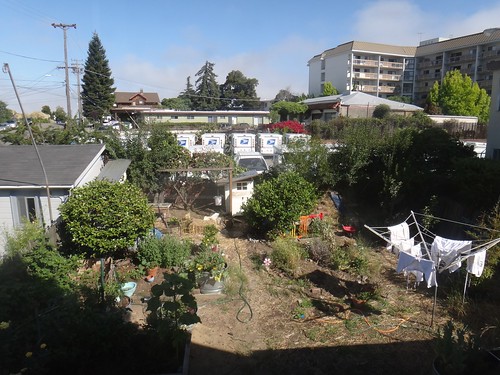
In late 2010 my partner and I bought a lovely 1896 Victorian in Oakland on 5,000 sq ft. It had stood empty for several years and had the usual urban squatters occupying the house and garden at various times. RE: various crack pipes in the attic, backyard overgrown, uncared for, and filled with broken glass and trash.Here's a picture of it in October 2009 when we first came to look at the house:Here it is about a year later. Not much is going on accept we have one raised bed in. We took out a couple of the rampant plum trees, pulled up tons of black plastic, a took out all the gross jade plant and a bunch of other boring stuff.November 2010:In summer of 2011 I put in an herb spiral in the center of the yard:August of 2011 we have TONS of veggies growing. This was the summer of the 20 million tomatoes and 10 million of zucchinis:Here it is right now. man, it looks pretty crappy from overhead...The herb spiral is mangy and cleared out and the over crop on the greensward area is not filled in. you can see our new big-ass white coop in the back left.June 2012:At some point early on my plan was to have a mostly native garden but I ditched that in favor of sticking with food plants and at least Mediterranean plants. There were just too many awesome plants out there to experiment with.Back yard == 2000 sq ftFruit trees so far: 2-3 plums, meyer lemon, lisbon lemon, orange, lime, two apples and two avocados.Animals: 6 chickensBeds: 2 large veggie beds, herb spiral with flower bed attached, native bed, 3 round planters with blueberries, strawberries, zucchini and herbs.Other elements:awesome chicken coop and run, embankment slide, kids playhouse area under lemon tree.Left over from some cute little old lady who must have lived here once: many pretty roses, fuschias and a camellia.Plans: Eventually I'll put in a native meadow for our grassy are and we'll have a deck. I keep waiting for the supposed construction we need to do on the house to be over but we keep not getting started with it so we just keep doing cover crops and our patio table is on an old rug. Our 2011 backyard had a sad dearth of actual flowers so, MOAR flowers!
I wrote about our process for building a labyrinth here a few weeks ago and I just returned from visiting it so I thought I would do an update.I could barely remember where it was and after four years of neglect I was worried that the stones would have shifted so the whole thing would be unrecognizable. Not to worry! It was obscured by tall grass but it was definitely all still there with minimal shifting of stones.Here is is 4 years ago: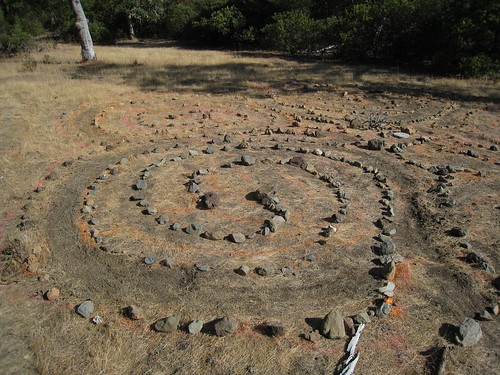 And here is my cute son who was 1 year old at the time. Mr. Helpy!
And here is my cute son who was 1 year old at the time. Mr. Helpy!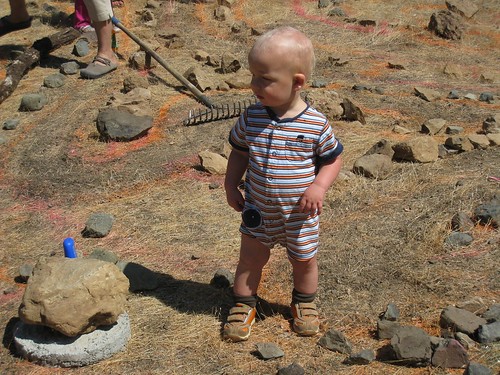 T and I started trampling the grass down and shifting stones back into place. one of the spiral arms remains a tad confused but it can be fixed later.Here is what we ended up with:
T and I started trampling the grass down and shifting stones back into place. one of the spiral arms remains a tad confused but it can be fixed later.Here is what we ended up with: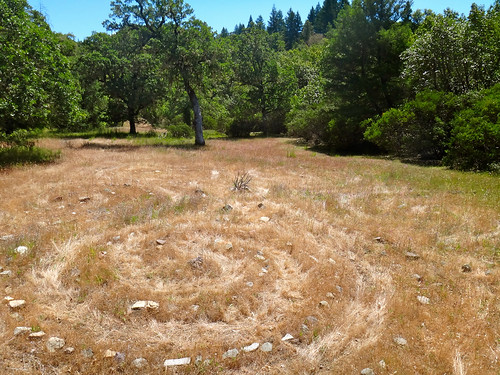 I would love to get sand or paving stones or something for that path way and really make the path more defined I guess I had better go camp up there more often. :)Here we are so you can get an idea of the scale. Each spiral arm is about 14-16 feet across.
I would love to get sand or paving stones or something for that path way and really make the path more defined I guess I had better go camp up there more often. :)Here we are so you can get an idea of the scale. Each spiral arm is about 14-16 feet across.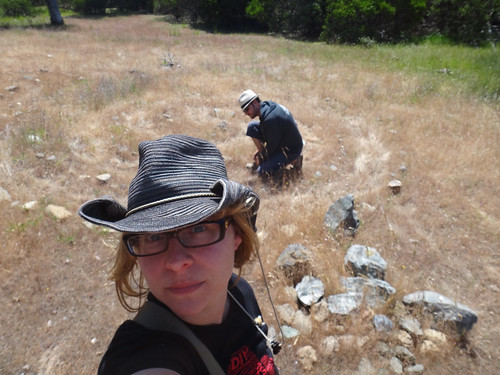 I highly recommend a labyrinth for backyards or play areas. They are cheap material-wise, if not labor wise, to build and can be a great community project and they require very little to no maintenance. Not only do they have great scope for the imagination for kids but adults love them too.
I highly recommend a labyrinth for backyards or play areas. They are cheap material-wise, if not labor wise, to build and can be a great community project and they require very little to no maintenance. Not only do they have great scope for the imagination for kids but adults love them too.
About 4 years ago I conceived a desire to build a labyrinth on the property of some friends who were having a "Leave a Trace" party. They have a bunch of acres of beautiful California chaparral up in Mendocino County and i thought a labyrinth would be a perfectly fit into the natural landscape and their use of the land for enjoyment of nature, fun, and relaxation.I can't remember where I experienced my first labyrinth but I love them very much. I wanted the one I made for them to be special and not the usual 7 circuit labyrinth (see here) that I usually see. Not that there is anything wrong with those at all. I just often chose a more complicated, challenging project than the status quo.
Five Auspicious CloudsAn internet search revealed a lovely pattern called the "Five Auspicious Clouds", that's a great name too. I had to look up the symbolism, of course and here is what I found,
"Clouds, sometimes referred to as "auspicious clouds" (xiangyun 祥云), represent the heavens and also "good luck" because the Chinese word for cloud (yun 云) is pronounced the same as yun (运) meaning "luck" or "fortune".The cloud is a commonly seen design and when repeated in a pattern symbolizes never-ending fortune."
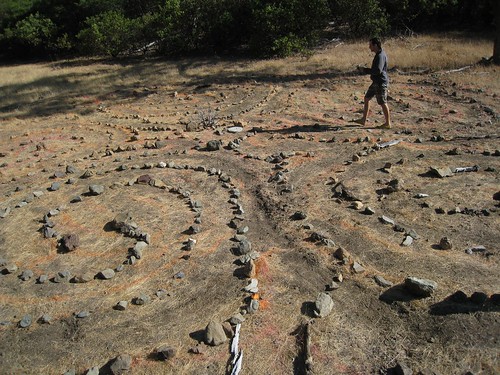 Four years ago this is what we did to build a laybrinthWe spent two days hauling rocks and gently arguing about how to lay them out. At the end of two days we had a perfectly laid out 5 Auspicious clouds labyrinth with one layer of rocks denoting the walls.How to build a meditation labyrinth using only some beer, a golf cart and a few river rocks:Step One: get beer and a big flat space:
Four years ago this is what we did to build a laybrinthWe spent two days hauling rocks and gently arguing about how to lay them out. At the end of two days we had a perfectly laid out 5 Auspicious clouds labyrinth with one layer of rocks denoting the walls.How to build a meditation labyrinth using only some beer, a golf cart and a few river rocks:Step One: get beer and a big flat space:  Okay seriously... I read around on the internets to see how other people did it but didn't find a whole lot. So, just now, in searching for the site that was helpful I found a couple more that look good, here they are:Labyrinth Enterprises FAQLabyrinthosLabyrinth SocietyWe weed wacked and we raked and moved large obstacles from the area.A rope with tape marked every 18 inches and rebar staked in the center help the rope in place as an inverted tip marking spray paint (as used in construction) was used to mark the perimeter.The design has 5 spiral arms and so we marked 5 lines at 72 degrees (apron. thank you math-y people!) and along each of these lines we marked each 18 inch segment with the spray paint.
Okay seriously... I read around on the internets to see how other people did it but didn't find a whole lot. So, just now, in searching for the site that was helpful I found a couple more that look good, here they are:Labyrinth Enterprises FAQLabyrinthosLabyrinth SocietyWe weed wacked and we raked and moved large obstacles from the area.A rope with tape marked every 18 inches and rebar staked in the center help the rope in place as an inverted tip marking spray paint (as used in construction) was used to mark the perimeter.The design has 5 spiral arms and so we marked 5 lines at 72 degrees (apron. thank you math-y people!) and along each of these lines we marked each 18 inch segment with the spray paint. I had decided hat we would draw each spiral arm from the center out and that seemed to work fairly well although I believe the engineers in the group did not agree. One of the best parts of this was seeing how my friends all differently went about working on this large group project. I think we all did pretty well for a group of horrible OCD control freaks. :P
I had decided hat we would draw each spiral arm from the center out and that seemed to work fairly well although I believe the engineers in the group did not agree. One of the best parts of this was seeing how my friends all differently went about working on this large group project. I think we all did pretty well for a group of horrible OCD control freaks. :P The best part was that Acrobat snuck back after we all left an RE-DID much of it. Hahaa.
The best part was that Acrobat snuck back after we all left an RE-DID much of it. Hahaa. We hauled rocks from the river bed to outline the walls and we will fill in with the more eventually. If you can get free materials like that I highly recommend it. Have you ever priced rocks? They are expensive! Sand and gravel will mark the path and a friend has just offered some pretty sounding paving stones as well. Which is great because I was originally envisioning paving stones but then did the aforementioned pricing...
We hauled rocks from the river bed to outline the walls and we will fill in with the more eventually. If you can get free materials like that I highly recommend it. Have you ever priced rocks? They are expensive! Sand and gravel will mark the path and a friend has just offered some pretty sounding paving stones as well. Which is great because I was originally envisioning paving stones but then did the aforementioned pricing...



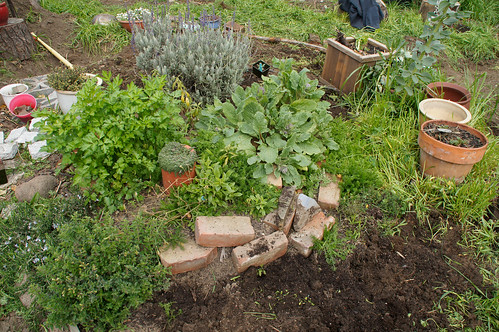
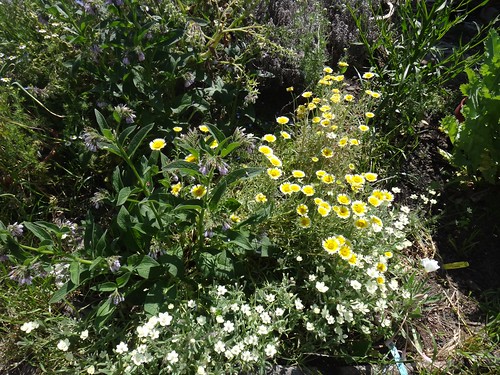
When we moved in and had an arborist come cut down some of the plum trees we kept all the branches. When I was making my herb spiral I dug a hole to mix in compost and such and I buried some of the plum branches in a nod to Hugelculture. We also piled up most of them along the back wall and dumped dirt on it and have things growing on it (oh, and an embedded hillslide) in a more traditional hugelculture bed.April 2011:It started fairly small.June 2011:I enlarged it to include an attached bed for flowers.October 2011:February 2012:Here's the flower part of it in May 2012:I had a fantastic crop of borage, chamomile and comfrey plus some nice annuals this spring. I have prepared the bed for some new things but I'm not sure what. I already sprinkled some seeds randomly and put in a few ground cherries. There is also some lovely lovely smelling lemongrass and some valerian in there plus some basic herbs like rosemary and oregano.Here it is June 2012: